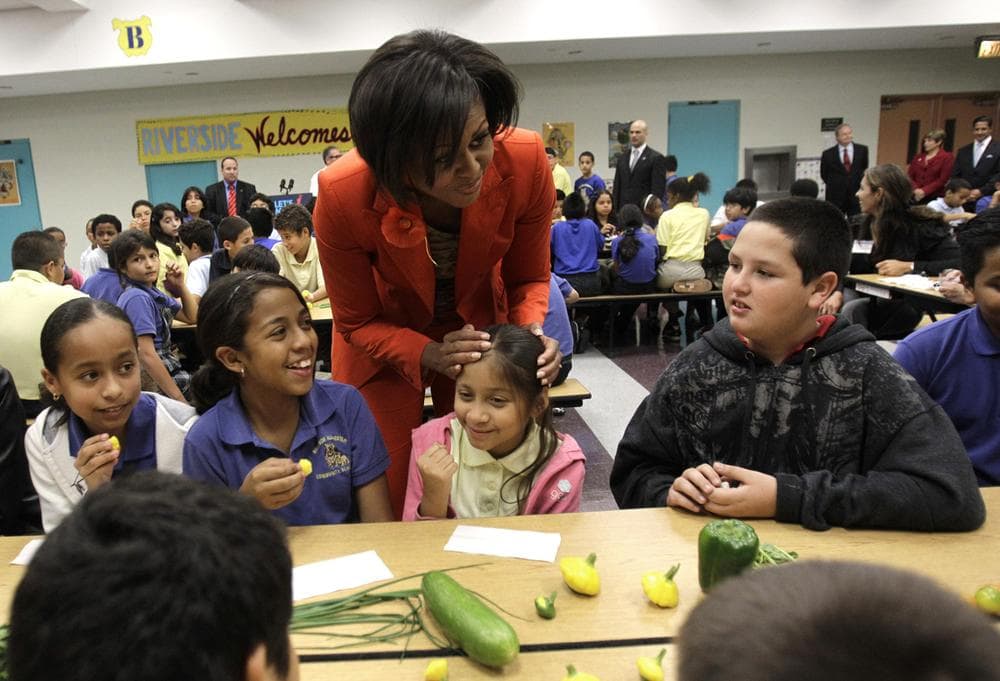Advertisement
Back To School: What's For Lunch?

It was a typically humid June day in Washington, D.C., and I was sitting in the White House Rose Garden surrounded by some 800 chefs, all dressed in white jackets and toques. We were there to hear First Lady Michelle Obama talk about her “Let’s Move” initiative to combat childhood obesity.
“You, more than anyone else can make a difference,” she told the congregation of sweaty chefs. “If each of you goes home and adopts a school in your area it could make a world of difference.”
After a quick tour of the White House vegetable garden, I rushed to the airport to catch my flight home. When I got on that plane a funny thing happened. It was like one of those cartoons where a tiny, black-caped devil sits on one shoulder, and a white-winged angel sits on the other. The devil whispered to me: “You are not an educator. You are a journalist. Go home, blog about the event, and move on with your life.” But the little angel had another, more provocative message: “You can make a difference.”
A week later, I called the principal of the local elementary school. I figured she would tell me she was too busy, there was no money, and thanks for trying. Instead she started hyperventilating when I mentioned Mrs. Obama and the White House initiative. “I’ll do anything to make this happen,” she told me.
Within a year, teachers, students of all ages, the PTO, a local landscape architect, farmers, and gardeners had joined forces to build a hoop house (an unheated, plastic-covered greenhouse) directly behind the elementary school. We planted peach and apple trees, blueberry and raspberry bushes. Every child in the school planted a seed for the hoop house: we grew unconventional vegetables like kale, Swiss chard, and popcorn, along with more common crops like peas, spinach, lettuce, and tomatoes.
I began teaching cooking and nutrition classes. I brought in local chefs to show the kids how delicious healthy eating can be. We made Swiss chard tacos, fruit smoothies, whole wheat pancakes, and homemade pasta mounded with sautéed garlic and garden spinach.
Despite the mythology that children will only eat “kid food” (pizza, chicken tenders, hot dogs, and burgers), these students devoured everything we cooked. Parents called me begging for the recipes. “My daughter loved the kale chips,” one mother told me. “She never eats anything green. What did you do?”
What did I do? The answer reminds me of the title of a book written by former First Lady, now Secretary of State Hillary Clinton, “It Takes a village.” One small elementary school in one small Maine town was waking up to the joys and health benefits of cooking fresh, organic food grown in their own backyard.
Despite the enthusiasm to eat green, when the kids return to school this fall the cafeteria will once again be doling out frozen French fries, hot dogs, and canned and frozen vegetables. There is little to no actual cooking that goes on inside the cafeteria. Most of the food that is served is prepackaged and frozen and re-heated.
The hard-working women who run the cafeteria in our town would like that to change. They would love to serve fresh, homemade food. (They have even asked for some of the recipes for the food we made with the kids.) But the school system, which requires the cafeteria to purchase food months in advance, doesn’t do much to promote menus that emphasize fresh fruits and vegetables. It’s more a matter of opening cans and freezer packs. This reheated “cooking” goes on in far too many public school cafeterias across the country.
A bill sponsored by Rep. Chellie Pingree (D-ME) would change this situation by allowing schools to spend their federal commodity dollars to buy fresh food directly from local farmers. The legislation is currently stalled – tied up with the Farm Bill, which Congress failed to pass before its summer recess.
As millions of American children get ready to go back to school this fall, equipped with brand new knapsacks, pencils, and "cool" lunch boxes decorated with images of super heroes and princesses, it’s worth taking time to think about what will get packed in those lunch boxes. What are you feeding your children? What are they eating for lunch at school? Can we do better? If the answer is yes, in my experience, the first step is getting your “village” involved.
This program aired on September 3, 2012. The audio for this program is not available.